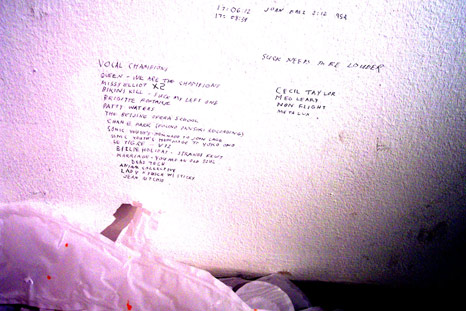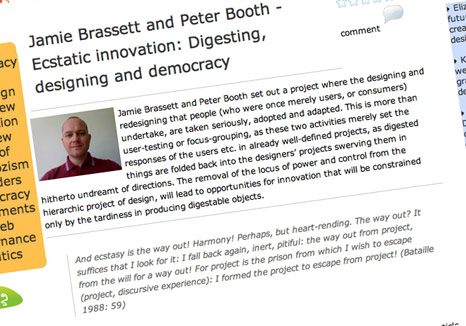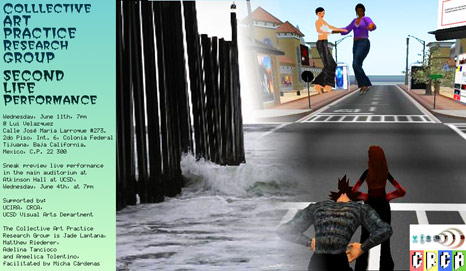政治纯形式办公室的图书馆 | Polit-Sheer-Form Office’s library
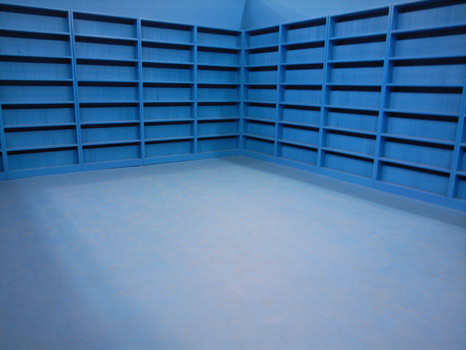 [《图书馆》2008年9月28日到11月15日在北京公社画廊。”Library” on exhibition 28 September – 15 November 2008 at Beijing Commune, Dashanzi Arts District ]
[《图书馆》2008年9月28日到11月15日在北京公社画廊。”Library” on exhibition 28 September – 15 November 2008 at Beijing Commune, Dashanzi Arts District ]
政纯办是什么?
政 纯办为政治纯形式办公室的简称,由洪浩、肖昱、刘建华、宋冬、冷林组成的艺术小组,在2005年创立“政治纯形式”概念,并以集体创作的方式进行工作。它 面向世界,聚焦精神世界的建设,将政治生活、文化生活、经济生活和日常生活等等纯形式化,模糊界限,将思考、讨论、足迹、享乐和思想等形成形式,构筑“政 治纯形式”概念。
“图书馆”
在 经济高速发展的当下社会,商业价值已经逐渐成为一种衡量纬度与判断体系渗透入我们的生活。在市场经济制度的催化下使个体不断自我膨胀而变得孤立。在这种个 人主义的世风下,使得个体与集体社会逐渐失去了健康的连接。政纯办这次在北京公社举办的“图展馆”装置展,则延续政纯办的精神,将”我们在一起的”这种集 体化的概念不断深化、提炼,并通过这种”集体”的方式,用“我们”的概念,来体现“我”的另一种形式,同时也是通过这种形式,来唤醒更加具有精神性,艺术 性的某种正在衰退的意识。“图书馆”试图要做的是将一种有关“集体的”、“我们的”精神性的集体意识通过一种媒介,一种共同的形式呈现出来。
政纯办小组的艺术家都是已经在艺术成就上非常成熟的艺术家,而由政纯办小组创作的“图书馆”装置作品也与他们个人的创作形成一种映射,成为他们个人创作的另一个方面。图书馆这一作品则是一种有关集体的、精神性的、艺术性的纯形式化的产物。
--------
What is Polit-Sheer-Form Office?
Polit-Sheer-Form Office, or PSFO in shortened form, is an art group founded in 2005 on the concept of collective art practice. Members of PSFO are Hong Hao, Xiao Yu, Liu Jianhua, Song Dong and Leng Lin. PSFO has a global vision and focuses on the construction of the mental world. The group’s art practice involves formalizing political, cultural, economic and daily life, blurring the boundaries between them, and transforming reflections, discussions, life tracks, and thoughts into sheer forms to construct the concept of “Polit-Sheer-Form”.
“Library”
Commercial values have permeated our life as a measurement system or criteria in the contemporary society which is undergoing rapid economic development. When getting more and more egotistical, individuals are also becoming isolated in the market-driven society, and the connection between the individual and the collective is gradually losing. The Polit-Sheer-Form Office carries on their spirit in the installation “Library” on show at Beijing Commune, trying to deepen and refine the idea of “We Are Together”. For PSFO, “the collective” is a way to show that “we” is another form of “I” and to awaken a more spiritual, artistic consciousness that is fading away. Through the collective creation of “Library”, the group tries to demonstrate an awareness of “the collective” which is about “we”.
The five members of Polit-Sheer-Form Office are all mature artists working independently in the art scene. As a collective work , “Library” becomes a contrast of their individual work as artists and also another side of their art practice. “Library” is a work about the spiritually collective presented through a sheer form.
Posted by Y| Comments Off on 政治纯形式办公室的图书馆 | Polit-Sheer-Form Office’s library“We – Collectivities, Mutualities, Participations”
Collectivity is something that takes place as we arbitrarily gather to take part in different forms of cultural activity such as looking at art. If we countenance that beyond all the roles that are allotted to us in culture –roles such as those of being viewers, listeners or audience members in one capacity or another — there are other emergent possibilities for the exchange of shared perspectives or insights or subjectivities — we allow for some form of emergent collectivity. Furthermore that performative collectivity , one that is produced in the very act of being together in the same space and compelled by similar edicts, might just alert us to a form of mutuality which cannot be recognised in the normative modes of shared beliefs, interests or kinship.
…
“If being-with is the sharing of a simultaneous space-time, then it involves a presentation of this space-time as such. In order to say ‘we’ one must present the ‘here and now’ of this ‘we’. Or rather saying ‘we’ brings about the presentation of the ‘here and now’, however it is determined; as a room, a region, a group of friends, an association, a ‘people’. We can never simply be the ‘the we’ understood as a unique subject … . ‘We’ always expresses a plurality, expresses ‘our’ being divided and entangled; ‘one’ is not ‘with’ in some general sort of way , but each time according to determined modes that are themselves multiple and simultaneous (people, culture,language, lineage, network, group, couple, band and so on). What is presented in this way, each time, is a stage (scène) on which several can say ‘I’ each on his own account, each in turn”. (Jean-Luc Nancy, “Being Singular Plural”)
[from the essay “We – Collectivities, Mutualities, Participations” by Irit Rogoff]
Posted by Y| Comments Off on “We – Collectivities, Mutualities, Participations”the suwud inquiry
Based on the multi-faceted character of the current artistic production field, and mapping the arrival and institutionalization of a phenomenon given by the merger of artistic production and new technologies for the production/distribution of images, this text will consider suwud‘s practices on the internet, from the perspective that the collective produces alternatives for the creative use and at the same time critical of this tool. More specifically, the aim here is to discuss one of its productions conceived and distributed over the internet: Googorama.
…Googorama, comprised only of information, with no material existence, when distributed over the internet, immediately becomes a source for debate; the result of these initial receptions becomes new information that couples to suwud‘s original proposal, which immediately will receive more information, also added to the ones before, and then adding another, and another, and so on.
…We can understand, through Googorama, that thinking art as information on the internet, is to experience in “real-time” what, a few years ago, Giulio Carlo Argan wrote about the fact that an artwork is its reality and everything that all generations have thought about it throughout history. In an accelerated time such as the one in which we live today, works that no longer possess material support –– comprised solely of information in an ongoing transformation process ––, update the Italian scholar’s definition. These new works configure a challenge to all who, coming from a formal tradition in the field of art history, face these new possibilities on thinking art.
********
Created in late 2005, suwud is composed by two physicists who are USP graduates (“Universidade de São Paulo”) and by a student of the “Departamento de Artes Plásticas” of the “Escola de Comunicações e Artes” in the same university. All three have varied interests that range from software programming to theater lighting, passing through philosophy, arts,
woodwork, photography and other areas.
The collective is not characterized solely by works made for the internet, or other “immaterial” media (such as video, for instance), its interest in actions that involve interventions in real spaces is noteworthy, by creating specific places/situations, in which the public’s participation is paramount.
… For a collective that, as I have already mentioned, manifests through several media, the issue of media specificity (still from a modernist perspective) is not contained amongst their main concerns, even though it appears as a certain “residue” in the conception/making of the works.
…However, to this new generation of artists – or at least to suwud’s components –, the main aspect regarding internet works is not this kind of specificity (despite its existence). What seems to interest them is the specificity of information that manifests through the mean with which the collective operates.
According to one of its components:
“Technology crates new problems to be faced. I think that our works explore some
specificities of more basic things. For instance, communication, instead of communication devices. Technology usually just facilitates certain procedures that existed prior. A saw and a circular saw do the same thing, despite the fact that one is capable of cutting much faster than the other. Thus, it seems to me that the differences between technologies, which can be understood as each one’s specificities, are rarely disclosed. Going back to my example: a saw’s movement is back and forth, but a circular saw’s movement is circular. These functional details diverge from the mechanical perspective, but produce similar results. It is possible to deal with technology’s specificity in this framework, but I believe suwud deals more with the result produced by a tool than with mechanic details. And this is maybe due to the fact that we have a certain intimacy with the tools we work with”.“… when we created it, the intention we had was simply revealing what Google
StreetView was. And, by selecting some images, and grouping them it was possible to understand better what it was we were browsing, these very odd world of photographs. Google StreetView is a giant 3 dimensional photograph. Something totally new and incredible. Our initial intention was simply showing, understanding and discussing what that was which was in front of us. This maybe is a fundamental suwud characteristic. Most of the time we are only trying to understand things around us, without adding complexity to the enormous chaos that the world already is.” (e-mail statement by Pedro Terra sent to the author on February 28th, 2008)
[full English version pdf of “Why art today? The suwud inquiry.” by Tadeu Chiarelli]
Posted by Y| Comments Off on the suwud inquirysubRosa collective
Autonomy is not a fixed, essential state. Like gender, autonomy is created through its performance, by doing/becoming; it is a political practice. To become autonomous is to refuse authoritarian and compulsory cultures of separation and hierarchy through embodied practices of welcoming difference… Becoming autonomous is a political position for it thwarts the exclusions of proprietary knowledge and jealous hoarding of resources, and replaces the social and economic hierarchies on which these depend with a politics of skill exchange, welcome, and collaboration. Freely sharing these with others creates a common wealth of knowledge and power that subverts the domination and hegemony of the master’s rule.
(image from Yes Species, a performative tableau by subRosa collective and James Pei-Mun Tsang)
Posted by Y| Comments Off on subRosa collectiveEcstatic innovation: Digesting, designing and democracy
[originally published at Re-public,
As happens in collaborative writing, we were already several and now only more so. This article marks a moment——one of many——a bringing together of vastly different discourses of expertise and theory that are amalgamated by us, by our names, by our practices. We are both teachers, philosophers and practitioners of product and packaging design to greater and lesser extents; and sometimes all at the same time. This is not a frivolous beginning. The mashing together——like good felt——of these several selves will be the point of this piece. If felt can have a point. To navigate different discourses and practices in order to create something that, even if for a fleeting moment, is creative, is what this piece is about. But it is also a testament to this idea of becoming felt; a material manifestation of its point. The next movement in this mashing up will be to send the ideas out to be chewed over by others and for their responses to be gathered back into the mix. This, too, is the point. We offer a way of designing that follows our principles and practice, in order to product truly innovative outcomes.
Digesting
We have written elsewhere about digesting design and will only mention briefly the main ideas here. Consumption has defined, for some years now, the relationship between people and things. This gives nuances to discussions of taste, of cultures of choice and a myriad other related notions. The hegemonic nature of this discourse of consumption has, however, glossed over some important differences that are in need of highlighting. Consumption is predominantly a mouth-centred activity and cannot stand for the “living-with” of designed objects that takes place (with some things: houses, furniture, white goods) over many years. Consumption and tasting can rarely stand more than 20 chews before the objects are broken down and sent off to other places, for other processes. We argue that these “other places”——where digestion happens——offer a better metaphor with which to understand the everyday, elongated practices that describe people’s real engagement with designed objects. For example, though we may have exercized judgments of taste in the initial purchase of our sofas——consuming them proper——after four years of living with these objects, when we are away from home but we know they are sitting there in our living rooms, we cannot be said to be consuming them still. Everything that defined the moment of consumption of this object has passed. Nevertheless this object remains in our lives, giving off different values as our lives change. We are left, then, with a refinement of the metaphor to account for the post-consumption life of objects: and this gives us digesting. We should remember that this is more than an issue of academic pedantry over definitions. When we fold the whole concept back into the design process, we find that such theorizing has real, material, everyday effects.
Designing
Designing, as practiced, is a teleological process. It starts with a brief, goes through a number of stages——sometimes folding back to earlier stages in a reiterative loop——before reaching a goal in an outcome. Innovation through design only happens within tightly controlled boundaries. For the philosopher and ex-monk Georges Bataille, such a process was a “project”; which defined the whole experience of something launched at a particular target. (This was also subsumed under the notion of discursive experience, which prioritized the values of the written, the rational and the logical over the passionate, the destructive and the creative; following Nietzsche’s Apollo versus Dionysos.) The design process already mentioned is such a project: discursive, teleological, constrained. Even when it tries to break out of these strictures——by, for example, making the User the Centre of Design—the project remains, even if the conditions according to which the goal is conceptualized shift slightly. The top-down project still rules——and either the Designer or the Client occupies this tyrannical position. We wonder whether a different conception of the design process will offer a different social, cultural and political outcome. Our contention is that this change will occur by following a design process motivated by a concept of digestion. We have found a project to do away with projects.
Innovating Democratically
For Bataille, doing away with project was “ecstatic”: ex-stasis, the moving out of rest, clinches the deal. Moving out of the top-down constraints of the design process into something more fluid and creative, as Bataille does philosophically, offers much. We say that recognizing the digestive nature of our engagement with designed things will provide a similar ecstasy of design process.
Designers have been used, over recent years, to looking at people and their practices as part of the design process. The use of Ethnography as a tool for doing design research is commonplace. Our initiative is to remove such observations from the hierarchy of control in which the Designer Knows All (discovering opportunities in insights) and reposition them in a way that allows people to initiate design opportunities through their digestions. Within a digestive project, the designing and redesigning that people (who were once merely users, or consumers) undertake, are taken seriously, adopted and adapted. This is more than user-testing or focus-grouping, as these two activities merely set the responses of the users etc. in already well-defined projects, as digested things are folded back into the designers’ projects swerving them in hitherto undreamt of directions. The removal of the locus of power and control from the hierarchic project of design, will lead to opportunities for innovation that will be constrained only by the tardiness in producing digestable objects.
Unlike the “sustainable innovation” discussed by Clayton Christensen (1997)——where innovation happens in tiny steps, building only slightly on what has gone before——or even his “disruptive innovation”—which targets different markets and/or uses with existing technologies——this ecstatic innovation allows the possibility for design projects to take utterly chaotic directions. The outcome of such a digestive approach is a process which is non-linear and non-teleological, where control of designing is bottom-up and truly democratic, where clients, designers and people——digesters all——can negotiate ecstatic innovation in properly creative ways.
——
References
– Bataille, G. 1988. Inner Experience. Translated by Leslie A. Boldt. New York: SUNY Press
– Brassett, Jamie & Peter Booth. 2008 forthcoming. ‘Design Digestion. Work in Progress.’ In Design Principles & Practices: An International Journal
– Christensen, C. 1997. The Innovator’s Dilemma. Boston: Harvard Business School Press
– Nietzsche, F. 1993. The Birth of Tragedy: Out of the Spirit of Music. Edited by Michael Tanner. Translated by Shaun Whiteside. London: Penguin Books Ltd.
the inoperative community
“… In passing to its limit, finitude passes “from” the one “to” the other: this passage makes up the sharing. moreover, there is no entity or hypostasis of community because this sharing, this passage cannot be completed. incompletion is its “principle,” taking the term “incompletion” in an active sense, however, as designating not insufficiency or lack, but the activity of sharing, the dynamic, if you will, of an uninterrupted passage through singular ruptures. that is to say, once again, a workless and inoperative activity. it is not a matter of making, producing, or instituting a community; nor is it a matter of venerating or fearing within it a sacred power–it is a matter of incompleting its sharing. sharing is always incomplete, or it is beyond completion and incompletion. for a complete sharing implies the disappearance of what is shared.”
(jean-luc nancy, the inoperative community)
Posted by f| Comments Off on the inoperative communityfrom “The challenge of working at the time of network”, interview by Il Manifesto with Ned Rossiter
Excerpts from Alessandro Delfanti and Ned Rossiter, ‘La sfida del lavoro al tempo della rete [The challenge of working at the time of network: Interview with Ned Rossiter]’, Il Manifesto, 1 May, 2008. Full interview here. Italian version here.
Posted by Y| Comments Off on from “The challenge of working at the time of network”, interview by Il Manifesto with Ned Rossiter“In many respects communication conditions the possibility of new political organizations. We could say that ‘the political’ of network societies is comprised of the tension between horizontal modes of communication and vertical regimes of control. Just think, for instance, of the ongoing battles between Internet and intellectual property regulators such as WIPO (World Intellectual Property Organization) and pirate networks of software, music or film distribution. Collaborative constitution emerges precisely in the instance of confrontation. In this sense, the horizontal and vertical axes of communication are not separate or opposed but mutually constitutive. Moreover, how to manage or deal with these two axes of communication is often a source of tension within networks. Here, we are talking about the problem of governance, and there are no universal models to draw on. More often than not, networks adopt a trial-and-error approach to governance. But it is better to recognize that governance is not a dirty word, but one that is internal to the logic and protocols of self-organization.
Practices of collaborative constitution are defined by struggle. There is no escape from struggle and the tensions that accompany collaborative relations. This is the territory of the political – a space of antagonism that in my view is much more complicated than Schmittian friend/enemy distinction. Again, it is the work of translation that reveals the multiplicity of tensions. As Naoki Sakai and Jon Solomon have written, translation is not about linguistic equivalence or co-figuration, but rather about the production of singularities through relational encounters. But let’s get a bit more concrete here. What is a relational encounter? It occurs through the instance of working or being with others. Of sharing, producing, creating, listening. Sustaining a range of idioms of experience is a struggle in itself – one that is rarely continuous, but rather continually remade and reassembled. This in turn is the recombinatory space and time of new institutions.
Let me try and briefly unpack this idea of new institutions and their relation to precarity. If we say that precarity is a common condition – one that traverses class and geocultural scales – then we can ask: what is the situation within which precarity expresses itself? The situation (concept + problem) will define the emergence of a new institution. Situation, here, consists of virtual/networked, material, affective, linguistic and social registers. We are of course always in a situation, but how to connect with others? The point of connection brings about tensions – the space of the political – and the ensemble of relations furnishes expression with its contours.”
gray)
)( )( )( )( )( )( )( )( )( )( )( )( )( )( )( )( )( )( )( )( )( )( )( )( )( )( )( )( )( )(
gray) (area is an low-key independent non-profit non-institution that operates during lazy summer time within gray area of friendships and vacations and cultural funding / production / distribution.
gray) (area presents works of contemporary and media art with focus on ones that fills the gap between those two art-worlds and discourses. preferable are programs that shifts the media and skipping the frame of simple definitions and interpretations.
gray) (area operates form the city of Korcula at Korcula island in Croatia, enjoying the free position of the cultural periphery and challenge of no context of neither contemporary nor media art within the close neighborhood. Periphery provides freedom of established cultural power-games, predictable fashionable key-words and double criteria [that depend on geo-political position of the art-producer] and other positions of predictable artist reputation’s building system of cultural industry, and become present even within the small media art culture circles.
gray) (area is protocol between a white cube and a black box.
gray) (area like it small and good and take-it-easy and don’t want to grow.
gray) (area is sensing creative economy of 21st Century in error.
gray) (area is hub of gray economy.
gray) (area is dead-end backbone of social not.work of contemporary cultural politics.
gray) (area is operating system of no.work.
gray) (area prefers diving in a crystal blue sea than silicon one.
gray) (area prefers periphery than center.
gray) (area like speaking Bad english.
)( )( )( )( )( )( )( )( )( )( )( )( )( )( )( )( )( )( )( )( )( )( )( )( )( )( )( )( )( )(
gray) (area is located 10 meters by the sea in the basement of The
Memorial Collection of Maksimilijan Vanka [http://www.hazu.hr/ENG/
MemColl_M_Vanka.html] . Put sv. Nikole 7 . Korcula
open daily 21 – 21 h or by appointment
gray) (area is summer-only initiative of Darko Fritz, darko@darkofritz.net / tel +31 [0] 91.5800193
Posted by Y| Comments Off on gray)cybermohalla
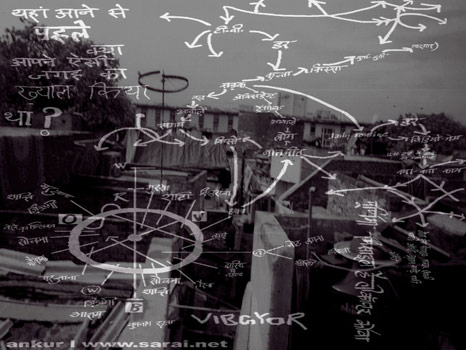
Mohalla in Hindi and Urdu means neighbourhood. Sarai’s Cybermohalla project takes on the meaning of the word mohalla, its sense of alleys and corners, its sense of relatedness and concreteness, as a means for talking about one’s ‘place’ in the city, and in cyberspace. Cybermohalla (May 2001-) is a collaborative project with Ankur: Society for Alternatives in Education.
* of note… cybermohalla’s game of No-Logs:
Posted by Y| Comments Off on cybermohallaWhen we speak, how do we make sense of the listener? The game of no-log is played when the listener keeps saying “I didn’t understand”. Without losing patience, a practitioner of no-logs keeps developing the argument or the story that s/he started to share. The practitioner has to go on and discover feelings, impressions, imageries, stories, anecdotes, examples, to make it increasingly difficult for the listener to say “I didn’t…”.
collective art practice research group
Collective Art Practice – Performative and Networked Approaches to Challenging Power
This class took place in the Spring 2008 quarter at UCSD, on Wednesday nights from 5-8pm. It was a VIS198 Directed Study Group. The class is supported by an Open Classroom grant from UCIRA and is receiving support from CRCA.
Class Overview
This class begins with the assumption that the contemporary world is an assemblage, a network of networks, a nested set of groupings at varying scales which are constantly in flux, temporary and shifting. Building on this assumption, the contemporary form of power has an assemblage structure, so does the contemporary form of resistance. A question follows the assumption, given this decentered, constantly shifting form of power, what are artists doing in response to challenge power?
One part of a response to this question will occupy the majority of this class: collective art practice. The class will look briefly at the history of collective art practice, its motivations and its trajectory, situating it within contemporary art practice. It will go on to look in more detail at contemporary art collectives and their motivations, their ties to contemporary politics of globalization and efforts to maintain an egalitarian or non-hierarchical collective practice.
This class has three main foci:
– to introduce students to collective practices
– to facilitate student understanding of social issues embodied in the san diego / tijuana borderlands
– to explore online space as public space, its limitations and possibilities
Syllabus
Week 1 – April 2: A Class Without A Teacher? Critical Pedagogy and Intro to Collective Practice
Readings: Selections from
bell hooks, Teaching to Transgress
Jo Freeman, The Tyranny of Structurelessness http://www.jofreeman.com/joreen/tyranny.htm or (pdf) http://struggle.ws/pdfs/tyranny.pdf
On Conflict and Consensus, At Least Ch 3, but Ch 1 is good too
Optional: Henry Giroux, Border Crossings: Cultural Workers and the Politics of Education
Presenters: Members of the Groundwork Books Collective
Week 2 – April 9: A Rich Legacy of Collective Practice
Readings: Selections from
AT A DISTANCE “Fluxus Practice”
Collectivism After Modernism: The Art of Social Imagination After 1945
A New Philosophy of Society, Manuel Delanda, Intro
Presenters: Brett Stalbaum, Ricardo Dominguez
Project Due: Login to class wiki and add a page about yourself and your work.
Week 3 – April 16: Social Sculpture, society is the sculpture, collectively creating change
Readings: Selections from
A New Philosophy of Society, Manuel Delanda, Ch. 1
Christoph Spehr, “Free Cooperation”
http://0100101110101101.org/home/portraits/essay.html
http://0100101110101101.org/home/performances/interview.html
http://0100101110101101.org/home/performances/video.html
Presenters: The Boredom Patrol of the Clandestine Insurgent Rebel Clown Army
Project Due: Form collective groups.
Week 4 – April 23: Transnational corporations, transnational resistance
Readings: Selections from
Horizontalism, Marina Sitrin
The Sixth Declaration of the Selva Lacandon
(original here, seems to be down http://www.ezln.org/documentos/2005/sexta1.en.htm)
Perpetual Restart. On the Hybrid Praxis of no one is illegal:
http://eipcp.net/transversal/1202/homann/en
Presenters: Members of Colectivo Zapatista and Simon Sedillo of El Enemigo Comun
Project Due: write a group statement of intention and post it in the class wiki or somewhere online.
Week 5 – April 30: Gaming Theory, “In Game” Resistance
Readings: Selections from
Desktop Theater: Keyboard Catharsis and the Masking of Roundheads, Adriene Jenik
Presenters: Adriene Jenik
Optional reading:
Why Youth (Heart) Social Network Sites: The Role of Networked Publics in Teenage Social Life
Profiles as Conversation: Networked Identity Performance on Friendster [pdf]
Week 6 – May 7: Autonomous Space in the Borderlands
The Electronic Disturbance, Nomadic Power and Cultural Resistance [pdf]
Border Postcard: Chronicles from the Edge ///
Resistance Against the Wall: A Report from the No Borders Camp
Trip to Tijuana to see the Lui Velazquez art space and meet with students from the Autonomous University of Baja California (UABC).
Readings:
Selections from Okupa! [rough cut] online video
Presenters: Members of the Lui Velazquez space, Claudia Algara
Project Due: Do a first performance in online public space using Second Life.
Week 7 – May 14: Collective Practice in the Borderlands
Read selections from Borderlands / La Frontera by Gloria Anzaldua
Presenters: Teddy Cruz, Architect and Associate Professor in the Visual Arts Department at UCSD.
Felipe Zuñiga, MFA Candidate, UCSD, part of Lui Velazquez
Ignacio Lopez, Discos Invisibles
Begin final project. For your final project, you must use Second Life as a site for a collective performance engaging with the social, political and aesthetic issues presented in this class. Your performance may involve one or more performers in virtual space and one or more performers in physical space. Your performance will be presented in class and, if you choose, at a public presentation the last week of class. Possible issues for consideration are public space, exclusion/inclusion/flows, national/social/ideological borders, identity as a social process, material/immaterial property, to name a few.
Discuss and work on final projects.
Week 8 – May 21: Gender, Sexuality and Erotic Art Practice
Readings:
On How Porn Can Teach Us All to Share by Sophie Le-Phat Ho
C’lick Me – A Netporn Studies Reader – read the introduction and optionally read this chapter: Ten Fragments on a Cartography of Post-Pornographic Politics by Tim Stüttgen
[high res or low res versions here]
Presenters: Member of the Sharing Is Sexy.org collective
Discuss and work on final projects.
Week 9 – May 28: DIY, Self-Publishing, Craftivism
Readings: selections from
- Greenzine, Christy Road
- Radical Pet, Margarat Nee
- Cyclette, Kim Riot
- MAKE and CRAFT magazines
- Craftivism.com
- Taking Back the Knit: Creating Communities Via Needlecraft, Betsy Greer
- Presenters: Grrrl Zines A Go-Go
Week 10 – June 4th: Present final projects in class
Other Readings and Resources
- Group Work, Temporary Services
- Homes not jails!: [a novel], Michael Steinberg
- The Cathedral and the Bazaar, Eric Raymond
- Stolen Sharpie Revolution: A DIY Zine Resource, Alex Wrekk
- Autonomous Media: Activating Resistance & Dissent, Frederic Dubois
- Unleashing the Collective Phantoms: Essays in Reverse Imagineering, Brian Holmes
- Ethno-Techno, La Pocha Nostra
- Paulo Freire, Pedagogy of the Oppressed
- Publics and Counterpublics, Michael Warner
- Joseph Beuys: The Reader
- the abc of tactical media, David Garcia and Geert Lovink
- Social Network Sites: Public, Private, or What? [pdf]
- Velvet Strike
- Gamer Theory
- Not For Rent: Conversations with Creative Activists in the U.K., Stacy Wakefield
- Porn Studies, Linda Williams
- Imaging Her Erotics, Carolee Schneeman
- Cyberfeminism, Next Protocols, Claudia Reiche and Verena Kuni
- C’LICK ME: A NETPORN STUDIES READER, Edited by Katrien Jacobs, Marije Janssen, Matteo Pasquinelli
Videos:
- “Get Rid of Yourself”, Bernadette Corporation
- “Couple in a Cage”, Guillermo Gomez Pena and Coco Fusco
- On Network Culture, Open Source Methodologies:
- Protocol, Alexander Galloway
- Exploit, Alexander Galloway
[full documentation of this course at: http://sharingissexy.org/wiki/CollectivePracticeClass]
Posted by Y| Comments Off on collective art practice research group
